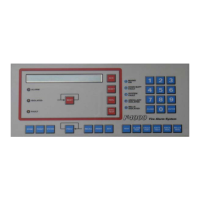Document No: LT0117 F4000 LCD Operator's Manual
System Description
Issue 2.38 19 April 2002 Page 2-23
OPERATIONAL DIFFERENCES (CONTINUED)
A number of keypad functions that take time to complete, eg. zone isolate/de-isolate and
zone searches, have a simple flashing asterisk that indicates that the function is still
operating.
A significant point to note is that the networking of FIPs introduces delays when showing
data and responding to commands. These delays did not exist where there was only a
single FIP to be controlled, because the information was immediately onhand. With
networks, this is not the case, and delays arise due to the time taken to access the
information.
Consequently, allowance must be made for these delays when operating a networked FIP.
The effect of these delays are noted below, and in the following sections for the affected
keypad commands.
There may be a noticeable delay at times when a network F4000 attempts to retrieve text
and status from another network panel. If there will be a delay, F4000 will display a minimal
description on the LCD, eg. Z1057 or Network Panel 75. The actual status will be shown
when the true zone name text (if programmed at the remote FIP) is displayed.
Operators of networked FIPs must be aware that they should wait until the FIP has retrieved
the information before issuing any command, partly to ensure that the command they send
will not have an adverse effect, i.e. deisolating a zone in alarm, and also because operators
on other FIPs or colour graphics displays may also be trying to control the same zone.
Confusion can also arise due to the delay if a zone has just been isolated: the FIP may
briefly indicate that the zone is not isolated. However, after at most a few seconds, the
display will be updated to show the correctly isolated status.
Network F4000 FIPs can combine the MAF status from other FIPs on the network. This
combined status is then used to drive brigade relays, etc.
F4000 V2.3xN has special handling for a Standby condition received from another FIP.
Remote Standby conditions do NOT result in the local FIP's Standby relay de-asserting
itself, rather, the remote Standby condition is treated as a System Fault, i.e. the fault relay
activates, the System Fault LED turns on, and the fault buzzer may sound. Standby and
System Fault from the other FIP can be viewed as separate items in the System Fault
Display.

